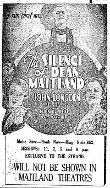 1260420295632418136.jpg
1260420295632418136.jpg
Advertisement, The Maitland Daily Mercury, 1 June 1934, p.2 (via Trove Australia)
Adaptation of
The Silence of Dean Maitland
1886
single work
novel
Issue Details:
First known date:
1934...
1934
The Silence of Dean Maitland


